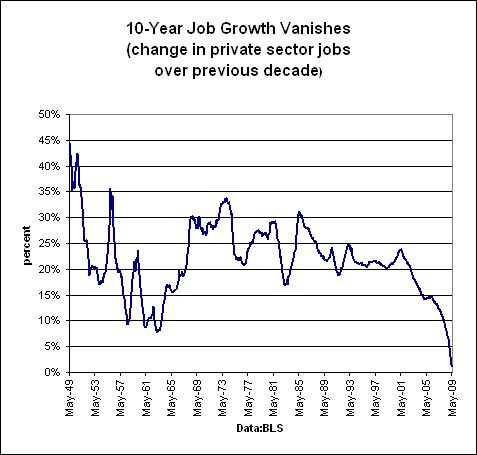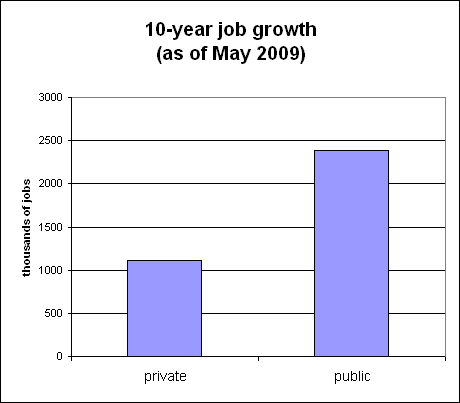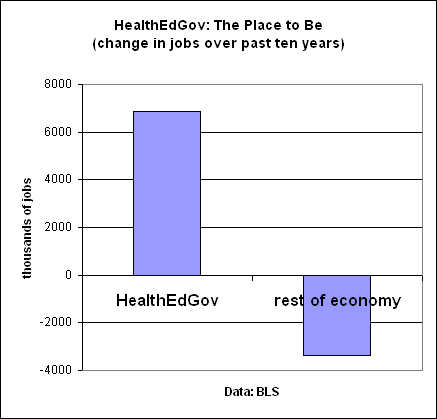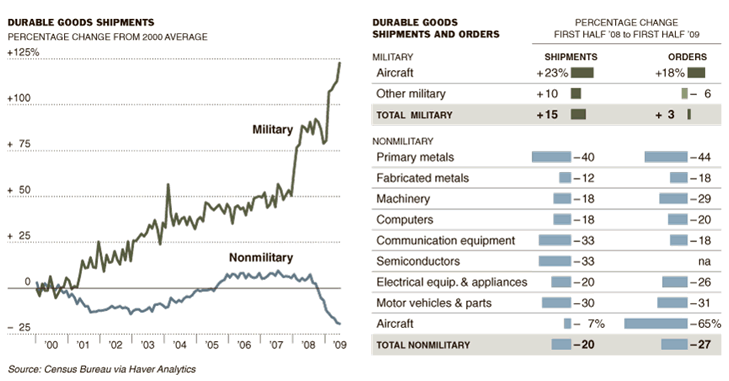U.S. Unemployment Now at Great Depression Levels, Jobs Destruction is Permanent
Economics / Unemployment Jun 03, 2011 - 06:00 AM GMTBy: Washingtons_Blog
 Unemployment During the Great Depression Has Been Overstated and Current Unemployment Understated (We've Now Got Depression-Level Unemployment)
Unemployment During the Great Depression Has Been Overstated and Current Unemployment Understated (We've Now Got Depression-Level Unemployment)
The commonly-accepted unemployment figures for the Great Depression are overstated.
 Specifically, government workers were counted as unemployed by Stanley Lebergott (the BLS economist who put together the most widely used numbers) ... even though gainfully employed and receiving a pay check.
Specifically, government workers were counted as unemployed by Stanley Lebergott (the BLS economist who put together the most widely used numbers) ... even though gainfully employed and receiving a pay check.
If we're trying to compare current unemployment figures with the Great Depression, the calculations of economists such as Michael Darby are more accurate.
Here is a comparison of Lebergott and Darby's unemployment figures:
Year Lebergott Darby
1929 3.2% 3.2%
1930 8.7% 8.7%
1931 15.9% 15.3%
1932 23.6% 22.9%
1933 24.9% 20.6%
1934 21.7% 16.0%
1935 20.1% 14.2%
1936 16.9% 9.9%
1937 14.3% 9.1%
1938 19.0% 12.5%
1939 17.2% 11.3%
1940 14.6% 9.5%
(see Robert A. Margo's Employment and Unemployment in the 1930s.)
We've Got Depression-Level Unemployment
Unemployment is currently underreported. Even government officials admit that their "adjustments" to unemployment figures are inaccurate during recessions.
In addition, the most widely-cited statistics use the Department of Labor's Bureau of Labor Statistics' "U-3" methodology. But "U-6" figures are more accurate, because they include people who would like full-time work, but can only find part-time work, or people who have given up looking for work altogether. U-6 is also is closer to the way unemployment was measured during the Great Depression than U-3
Current levels of unemployment are Depression-level numbers, especially when compared to Darby's figures.
For example, economist John Williams puts current U-6 unemployment at 15.9%. That's higher than 9 out of 12 years charted by Darby.
And there are certainly Depression-level statistics in some states. For example, official Bureau of Labor Statistics numbers put U-6 above 20% in several states:
California: 22.0
Nevada: 23.7
Michigan 20.3
(and Los Angeles County has 24.1% unemployment, higher than any of the Depression years as reported by Darby)
Williams puts SGS unemployment - which he claims is the most accurate measure - at 22.3%. That's higher than 11 out of 12 years charted by Darby.
Youngstown State University's Center for Working Class Studies puts the "De Facto Unemployment Rate" at 28.76%. I'm not sure if that compares to methods used during the Great Depression, but it surpasses all 12 out of 12 years charted by Darby.
More People Are Unemployed than During the Great Depression
As I noted in January 2009:
In 1930, there were 123 million Americans.
At the height of the Depression in 1933, 24.9% of the total work force or 11,385,000 people, were unemployed.
Will unemployment reach 25% during this current crisis?
I don't know. But the number of people unemployed will be higher than during the Depression.
Specifically, there are currently some 300 million Americans, 154.4 million of whom are in the work force.
Unemployment is expected to exceed 10% by many economists, and Obama "has warned that the unemployment rate will explode to at least 10% in 2009".
10 percent of 154 million is 15 million people out of work - more than during the Great Depression.
Given that the broader U-6 measure of unemployment is currently around 17% (ShadowStats.com puts the figure at 22%, and some put it even higher), the current numbers are that much worse.
Unemployment is Long-Term
USA Today reported in December:
So many Americans have been jobless for so long that the government is changing how it records long-term unemployment.
Citing what it calls "an unprecedented rise" in long-term unemployment, the federal Bureau of Labor Statistics (BLS), beginning Saturday, will raise from two years to five years the upper limit on how long someone can be listed as having been jobless.
***
The change is a sign that bureau officials "are afraid that a cap of two years may be 'understating the true average duration' — but they won't know by how much until they raise the upper limit," says Linda Barrington, an economist who directs the Institute for Compensation Studies at Cornell University's School of Industrial and Labor Relations.
***
"The BLS doesn't make such changes lightly," Barrington says. Stacey Standish, a bureau assistant press officer, says the two-year limit has been used for 33 years.
***
Although "this feels like something we've not experienced" since the Great Depression, she says, economists need more information to be sure.
The Wall Street Journal noted in July 2009:
The average length of unemployment is higher than it's been since government began tracking the data in 1948.
***
The job losses are also now equal to the net job gains over the previous nine years, making this the only recession since the Great Depression to wipe out all job growth from the previous expansion.
The Christian Science Monitor wrote an article in June entitled, "Length of unemployment reaches Great Depression levels".
60 Minutes - in a must-watch segment - notes that our current situation tops the Great Depression in one respect: never have we had a recession this deep with a recovery this flat. 60 Minutes points out that unemployment has been at 9.5% or above for 14 months.
Pulitzer Prize-winning historian David M. Kennedy notes in Freedom From Fear: The American People in Depression and War, 1929-1945 (Oxford, 1999) that - during Herbert Hoover's presidency, more than 13 million Americans lost their jobs. Of those, 62% found themselves out of work for longer than a year; 44% longer than two years; 24% longer than three years; and 11% longer than four years.
Blytic calculated last year that the current average duration of unemployment is some 32 weeks, the median duration is around 20 weeks, and there are approximately 6 million people unemployed for 27 weeks or longer.
As Calculated Risk noted last month:
According to the BLS, there are 5.839 million workers who have been unemployed for more than 26 weeks and still want a job. This was down from 6.122 million in March. This remains very high, and is one of the defining features of this employment recession.
Job Destruction is Permanent
Many leading economists say that America is suffering a permanent destruction of jobs.
For example, JPMorgan Chase’s Chief Economist Bruce Kasman told Bloomberg:
[We've had a] permanent destruction of hundreds of thousands of jobs in industries from housing to finance.
The chief economists for Wells Fargo Securities, John Silvia, says:
Companies “really have diminished their willingness to hire labor for any production level,” Silvia said. “It’s really a strategic change,” where companies will be keeping fewer employees for any particular level of sales, in good times and bad, he said.
And former Merrill Lynch chief economist David Rosenberg writes:
The number of people not on temporary layoff surged 220,000 in August and the level continues to reach new highs, now at 8.1 million. This accounts for 53.9% of the unemployed — again a record high — and this is a proxy for permanent job loss, in other words, these jobs are not coming back. Against that backdrop, the number of people who have been looking for a job for at least six months with no success rose a further half-percent in August, to stand at 5 million — the long-term unemployed now represent a record 33% of the total pool of joblessness.
Despite What the Government Says, Reducing Unemployment Is a Very Low Priority
While government officials talk a good game, government policy has actually not been geared towards fighting inflation, not creating more jobs.
Some Jobs Are Being Created ... But Mainly In the Military
127,000 jobs need to be created each month just to make sure that things aren't getting worse. (127,000 is the monthly population increase in the United States.)
But - according to ADP - last month only 38,000 jobs were created in the private sector.
There is fierce debate about how much the government has spent to create a few measly jobs. Some say that it is an insane amount, while others say the figure is lower. And see this .
But the truth is that there wasn't very much government stimulation aimed towards creating jobs at all ... other than in the military. As I pointed out in 2009, public sector spending - and mainly defense spending - has accounted for virtually all of the new job creation in the past 10 years:
The U.S. has largely been financing job creation for ten years. Specifically, as the chief economist for BusinessWeek, Michael Mandel, points out, public spending has accounted for virtually all new job creation in the past 10 years:
Private sector job growth was almost non-existent over the past ten years. Take a look at this horrifying chart:

Between May 1999 and May 2009, employment in the private sector sector only rose by 1.1%, by far the lowest 10-year increase in the post-depression period.
It’s impossible to overstate how bad this is. Basically speaking, the private sector job machine has almost completely stalled over the past ten years. Take a look at this chart:

Over the past 10 years, the private sector has generated roughly 1.1 million additional jobs, or about 100K per year. The public sector created about 2.4 million jobs.
But even that gives the private sector too much credit. Remember that the private sector includes health care, social assistance, and education, all areas which receive a lot of government support.
***
Most of the industries which had positive job growth over the past ten years were in the HealthEdGov sector. In fact, financial job growth was nearly nonexistent once we take out the health insurers.
Let me finish with a final chart.

Without a decade of growing government support from rising health and education spending and soaring budget deficits, the labor market would have been flat on its back.
Indeed, Robert Reich lamented last year:
America’s biggest — and only major — jobs program is the U.S. military.
Raw Story argues that the U.S. is building a largely military economy:
The use of the military-industrial complex as a quick, if dubious, way of jump-starting the economy is nothing new, but what is amazing is the divergence between the military economy and the civilian economy, as shown by this New York Times chart.
In the past nine years, non-industrial production in the US has declined by some 19 percent. It took about four years for manufacturing to return to levels seen before the 2001 recession -- and all those gains were wiped out in the current recession.
By contrast, military manufacturing is now 123 percent greater than it was in 2000 -- it has more than doubled while the rest of the manufacturing sector has been shrinking...
It's important to note the trajectory -- the military economy is nearly three times as large, proportionally to the rest of the economy, as it was at the beginning of the Bush administration. And it is the only manufacturing sector showing any growth. Extrapolate that trend, and what do you get?
The change in leadership in Washington does not appear to be abating that trend...
So most of the job creation has been by the public sector. But because the job creation has been financed with loans from China and private banks, trillions in unnecessary interest charges have been incurred by the U.S. And this shows military versus non-military durable goods shipments:

So we're running up our debt (which will eventually decrease economic growth), but the only jobs we're creating are military and other public sector jobs.
This might be okay from a strictly economic (as opposed to moral) perspective if defense jobs reduced unemployment. But, as many economists point out, the fact is that massive military spending actually increases unemployment in the long-run.
For example, PhD economist Dean Baker notes that America's massive military spending on unnecessary and unpopular wars lowers economic growth and increases unemployment:
Defense spending means that the government is pulling away resources from the uses determined by the market and instead using them to buy weapons and supplies and to pay for soldiers and other military personnel. In standard economic models, defense spending is a direct drain on the economy, reducing efficiency, slowing growth and costing jobs.
A few years ago, the Center for Economic and Policy Research commissioned Global Insight, one of the leading economic modeling firms, to project the impact of a sustained increase in defense spending equal to 1.0 percentage point of GDP. This was roughly equal to the cost of the Iraq War.
Global Insight’s model projected that after 20 years the economy would be about 0.6 percentage points smaller as a result of the additional defense spending. Slower growth would imply a loss of almost 700,000 jobs compared to a situation in which defense spending had not been increased. Construction and manufacturing were especially big job losers in the projections, losing 210,000 and 90,000 jobs, respectively.
The scenario we asked Global Insight [recognized as the most consistently accurate forecasting company in the world] to model turned out to have vastly underestimated the increase in defense spending associated with current policy. In the most recent quarter, defense spending was equal to 5.6 percent of GDP. By comparison, before the September 11th attacks, the Congressional Budget Office projected that defense spending in 2009 would be equal to just 2.4 percent of GDP. Our post-September 11th build-up was equal to 3.2 percentage points of GDP compared to the pre-attack baseline. This means that the Global Insight projections of job loss are far too low...
The projected job loss from this increase in defense spending would be close to 2 million. In other words, the standard economic models that project job loss from efforts to stem global warming also project that the increase in defense spending since 2000 will cost the economy close to 2 million jobs in the long run.
And the Political Economy Research Institute at the University of Massachusetts, Amherst has also shown that non-military spending creates more jobs than military spending.
Government policy has largely caused the current unemployment crisis. And until Washington and Wall Street are forced to change course, things will not meaningfully and significantly improve for a long time.
Global Research Articles by Washington's Blog
© Copyright Washingtons Blog, Global Research, 2011
Disclaimer: The views expressed in this article are the sole responsibility of the author and do not necessarily reflect those of the Centre for Research on Globalization. The contents of this article are of sole responsibility of the author(s). The Centre for Research on Globalization will not be responsible or liable for any inaccurate or incorrect statements contained in this article.
© 2005-2022 http://www.MarketOracle.co.uk - The Market Oracle is a FREE Daily Financial Markets Analysis & Forecasting online publication.



